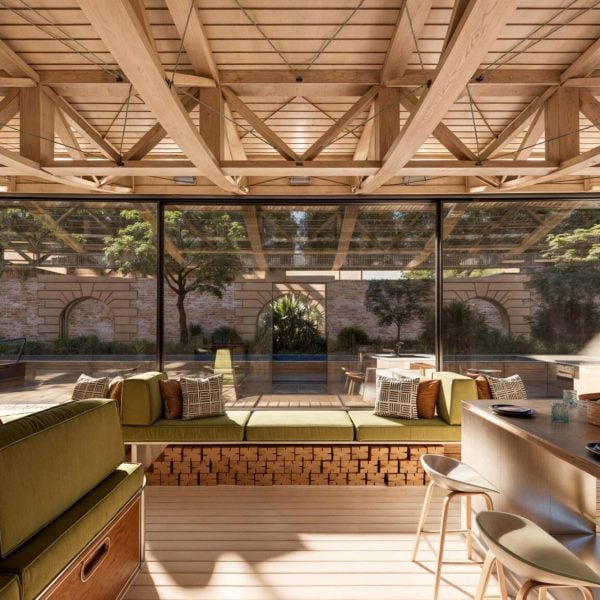Eight innovative designs have been shortlisted for Dezeen and Bentley’s Start Something Powerful Competition, which called for pioneering proposals that reimagine the way future generations live over the next 100 years.
Entrants from more than 34 countries entered the contest, which challenged contestants to envision architecture or design concepts that respond to rapid advancements in technology, evolving societal norms and environmental concerns to transform people’s lives.
Through the design contest, Dezeen and Bentley aim to discover prototypes that could serve as a blueprint for future living, anticipating the needs, technologies and lifestyle trends for the next century.
Eight designs have now been shortlisted and are in the running for a share of the £30,000 prize pot. The winners will be revealed later this month.
The winner will receive a top prize of £15,000, while the runner-up will receive £10,000 and the third-placed entrant will receive £5,000.
The shortlisted entries are listed below in the order that they were submitted.
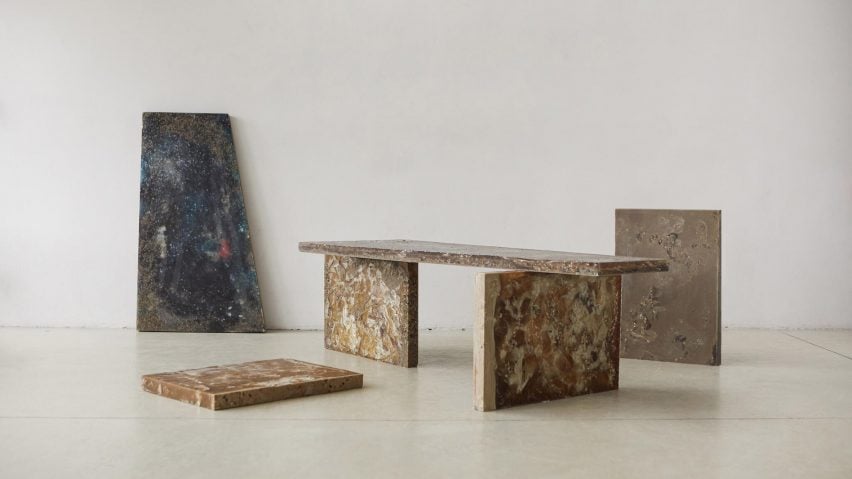
Foil & Soil by Magdalena Pietryszyn and Magdalena Skowyra
Warsaw, Poland
Architect Magdalena Pietryszyn and polymer scientist Magdalena Pietry teamed up to develop Foil & Soil, a post-plastic material made by combining agricultural waste with plastic debris.
The process involves upcycling low-density polyethylene (LDPE) foil and infertile soil. The resulting conglomerate blends the rough texture of soil sediments with the reflective qualities of polyethylene foil.
While the composition of Foil & Soil can be reproduced, each batch retains a distinct, striking appearance.
The concept envisions sourcing materials from rural areas to promote community engagement and foster bioregions that integrate environmental sustainability with cultural and material innovation.
“Foil & Soil embraces a fearless, material-focused approach that transforms the undesired matter from agricultural to applied settings,” the designers said.
“The concept sees synthetic and organic matter intermingle with various binders across diverse scales and settings, spanning public, domestic and productive environments.”
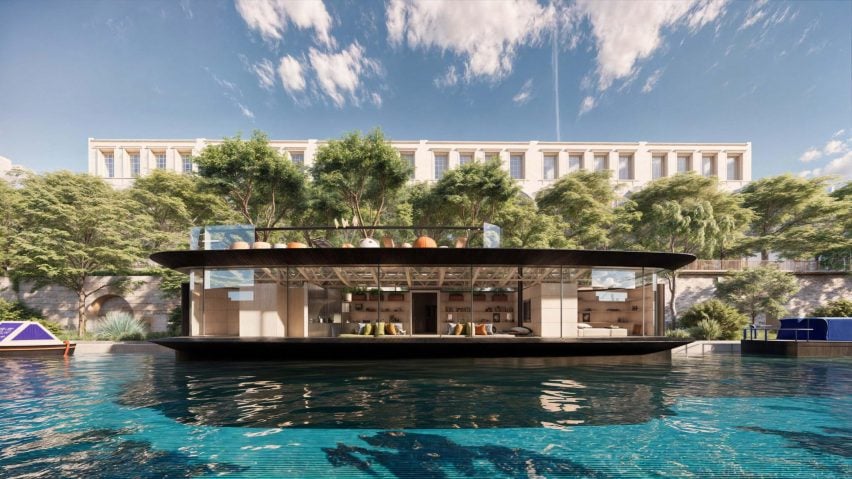
Vessel by Asher Bourne
London, UK
Asher Bourne proposed an affordable housing solution that leverages the UK’s extensive canal system. Named Vessel, the concept reimagines the country’s housing model to promote community engagement and combat social isolation by creating vibrant canal neighbourhoods in urban areas.
Bourne’s design features sleek, prefabricated homes crafted from sustainably sourced timber and high-performance glass.
These compact homes are designed to be stationary, eliminating the need for constant relocation while offering enhanced insulation compared to traditional canal boats. They incorporate solar panels and sustainably sourced wood for heating.
Bourne envisions the Vessel concept extending beyond housing, with possibilities for community centres and retail spaces, transforming underutilised waterways into dynamic new neighbourhoods.
“Canal boat living offers a unique blend of community, nature and urban proximity,” Bourne said. “Whether it’s the vibrant scenes along Regent’s Canal or the peaceful stretches of the Kennet and Avon.”
“For many young professionals, it’s a way to escape the rental market and own a slice of the city, town or countryside,” he continued.

Central Market of the New Lake of Tlahuac-Xico by Alberto Sainz, Alonso Varela and Maximiliano Colorado
Mexico City, Mexico
Designers Alberto Sainz, Alonso Varela and Maximiliano Colorado’s concept aimed to demonstrate how targeted interventions can foster sustainable living and serve as a blueprint for future urban planning initiatives.
Lake Tláhuac-Xico exemplifies this, as its changing role in the Mexico Valley Basin reflects significant challenges such as the loss of the natural lacustrine landscape, increasing differential subsidence causing structural damage and a lack of clean public spaces.
The deterioration of the basin’s aquatic environments has intensified issues such as drinking water shortages, flooding and the encroachment of urban development over illegal waste dumps in the lake area.
The designer’s masterplan focuses on preventing urban sprawl and enhancing the area’s ecological health. It includes strategies to clean up illegal dumps, restore existing wetlands, improve public transportation and create green public spaces.
Strategies such as recycling construction debris, establishing new wetlands and improving transportation connectivity contribute to reducing the carbon footprint while converting waste into a valuable resource for ecological restoration in the area.
“The project seeks to justify Lake Tláhuac-Xico’s continued existence as an active urban space,” the designers said.
“The market not only creates a new body of water through wastewater treatment but also supports aquaculture, which drives productive circular economies.”
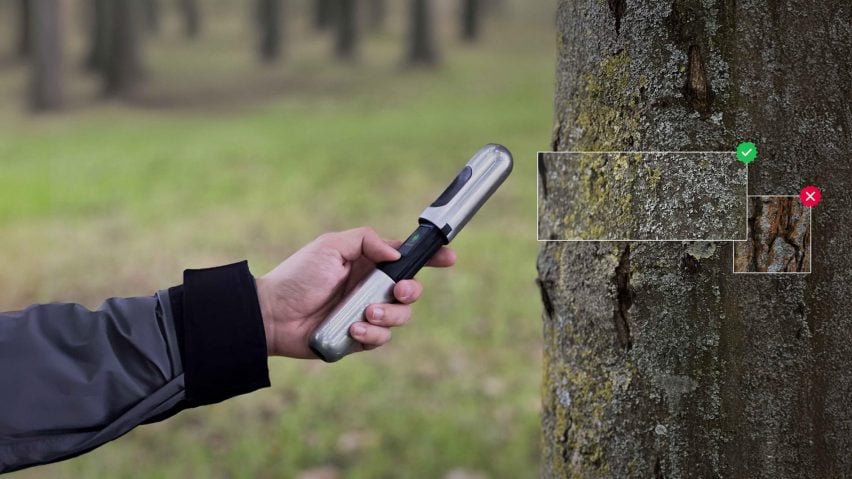
EarthCode by Hanju Seo
London, UK
Hanju Seo proposed a system to make tree identification easier and cheaper for verifying carbon storage. Called EarthCode, the concept draws on centuries-old methods of tree identification, where forest managers would identify trees by their bark patterns.
Seo’s proposal updates this approach with a handheld scanner that uses artificial intelligence to create unique “Bark-Codes,” improving the accuracy and security of carbon credit verification.
EarthCode would help ensure that carbon credits are based on accurate, tamper-proof data, contributing to better forest management and environmental protection.
The EarthCode system is designed to help small forest owners take part in carbon offset markets, which reward landowners for capturing carbon dioxide in their forests.
“EarthCode is a pioneering system designed to democratise the carbon offset market,” Seo said.
“The system not only utilises cutting-edge technology but also honours traditional methods of tree identification, creating a bridge between heritage and modern innovation.”
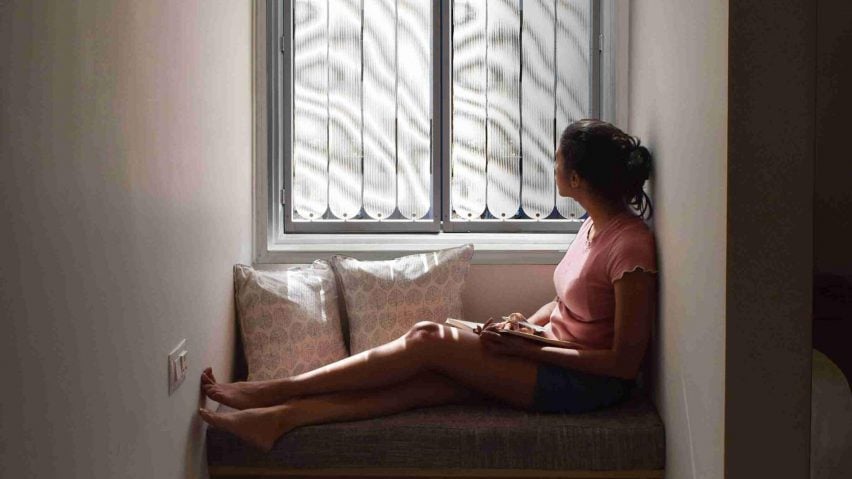
TranSense Screens by Saima Fateh
London, UK
Saima Fateh’s proposal reimagines conventional shading systems by leveraging smart materials to automatically adjust to varying temperatures and UV light without needing electricity.
Called TranSense Screens, the shading system is intended for hot climates, aiming to enhance indoor comfort. The screens would passively regulate indoor temperatures, reducing reliance on air conditioning and lowering energy consumption.
Unlike traditional motorised systems, TranSense Screens would utilise Nitinol springs that contract and expand with temperature variations, meaning they could adapt in real-time based on changing environmental conditions.
The screens would incorporate colour-changing photochromic pigments that serve as a visual indicator of UV levels, enhancing user awareness and prompting protective measures against exposure.
“TranSense Screens presents a forward-looking vision of how future generations can form a sensory relationship with their environment,” Fateh said.
“Offering a transformative approach to shading systems, they have the potential to significantly improve the quality of life in hot regions, empowering people to live more fulfilling and environmentally conscious lives for generations to come.”
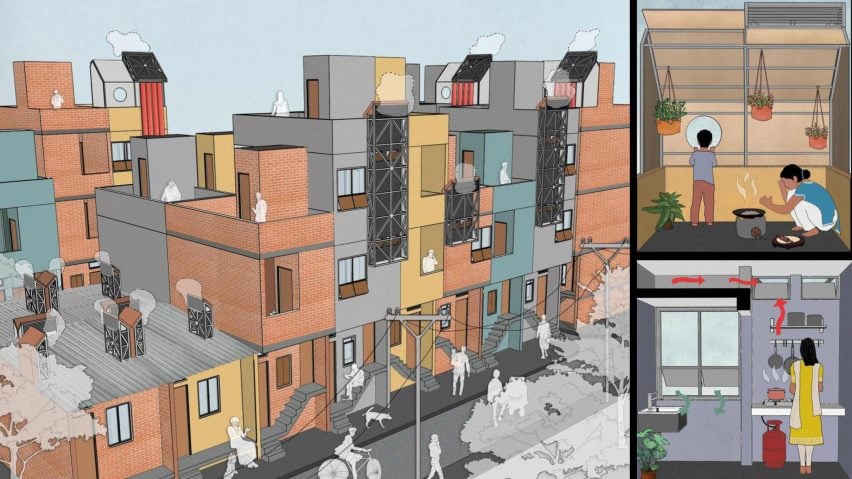
BreatheEasy by Architecture for Dialogue
Delhi-NCR, India
Research and design consultancy Architecture for Dialogue created BreatheEasy, a retrofit initiative designed to improve indoor air quality in homes, particularly in polluted areas like informal settlements.
The concept involves employing traditional ventilation techniques, such as solar chimneys and wind catchers, to naturally ventilate spaces and reduce harmful indoor air pollution by harnessing solar energy and wind currents.
BreatheEasy solutions can be retrofitted to existing structures, ensuring that residents can enhance their living conditions without extensive renovations or high costs.
The affordable and adaptable solutions enable a broader range of households to benefit from improved air quality.
“BreatheEasy creatively adapts long-lost vernacular ventilation techniques to combat the contemporary air pollution crisis within homes,” the designers said.
“The project demonstrates a design-led approach to housing upgradation in India and other cities around the globe, demonstrating how cost-effective solutions can work as interventions or add-ons to existing structures.”
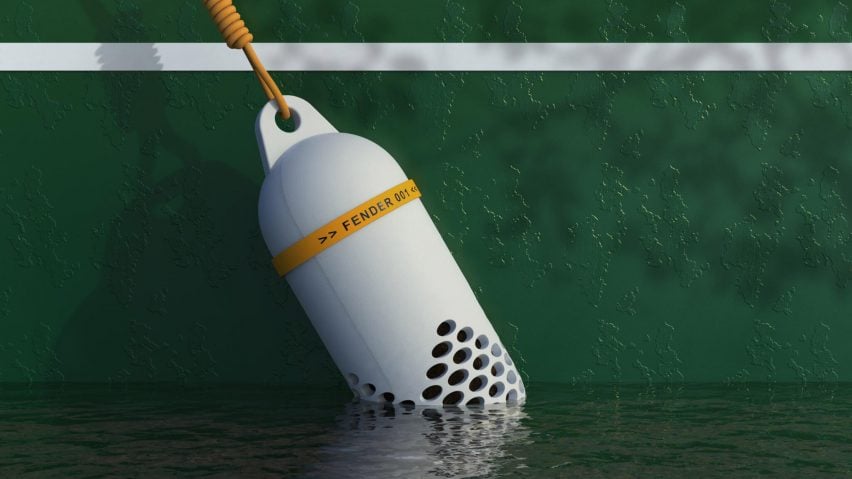
Bio-Fender by Rehan Petit
London, UK
Rehan Petit designed Bio-Fender, a boat bumper for narrowboats in British canals that would help clean up oil spills while also protecting the boats.
When the Bio-Fender encounters oil, coconut coir absorbs the oil and brings it into contact with microbes that metabolise it into harmless substances such as water and carbon dioxide.
The process is designed to clean the water naturally without the use of harmful chemicals or disruptive interventions, preserving the canal ecosystem and boaters’ activities.
By harnessing nature to clean the water, Bio-Fender would turn potentially harmful spills into an opportunity for environmental restoration.
“The beauty of bioremediation in Bio-Fender is its simplicity and efficiency,” Petit said.
“By embedding biodegradable materials and bioremediation agents into Bio-Fender, the project offers a sustainable intervention that actively mitigates pollution without disrupting the daily rhythm of canal life.”
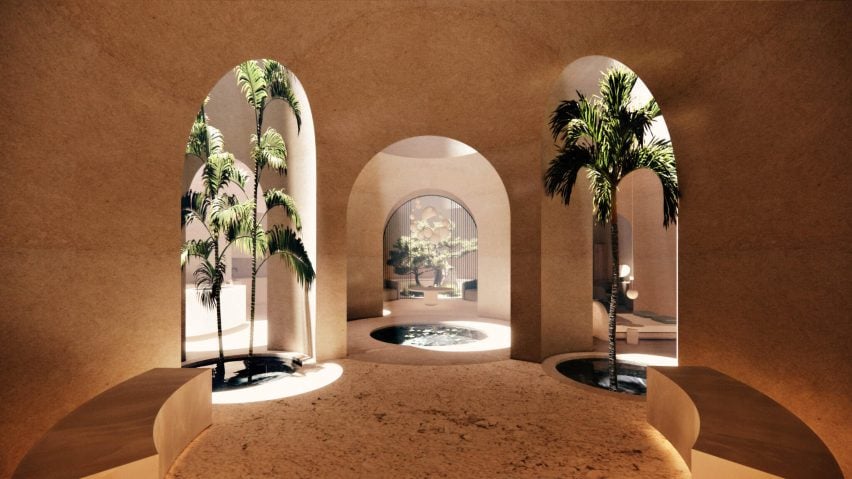
Shadows of the Oases by Matthew Pratt
London, UK
Matthew Pratt envisioned a future where people can thrive amid the harsh conditions of the desert landscape through underground sanctuaries carved from the earth.
His concept, called Shadow of the Oases, draws from ancient architectural techniques and historical structures such as the rock-carved city Petra, the caves of Cappadocia and the troglodyte homes of Matmata in the Sahara, where subterranean living has long provided shelter from extreme climates.
Pratt proposes that the structures would utilise the earth’s natural insulating properties to moderate extreme temperatures, reducing reliance on artificial heating and cooling.
By using the earth as the primary building material and incorporating passive environmental design techniques, the spaces are designed to be self-sufficient with minimal impact on the environment above.
“Shadow of the Oases is not just a response to the desert’s challenges but a celebration of its potential,” Pratt said.
“It offers a poetic yet practical vision for the future, where humanity can coexist with even the most extreme environments.”
Partnership content
The Start Something Powerful Competition is a partnership between Dezeen and Bentley. Find out more about Dezeen partnership content here.

